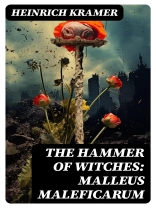The Hammer of Witches, known as Malleus Maleficarum, is a seminal text in the canon of witchcraft literature, co-authored by Heinrich Kramer and Jacob Sprenger in 1487. This treatise intricately intertwines legal discourse, ecclesiastical authority, and folk superstition, providing a systematic guide for the identification, prosecution, and punishment of witches. Employing a didactic literary style, the book legitimizes the inquisitorial methods of its time while reflecting the prevailing misogyny and fear-driven attitudes of the late medieval period, making it a pivotal work in understanding both the witch hunts and the cultural zeitgeist of Europe during this dark chapter in history. Heinrich Kramer, a Dominican friar and inquisitor, was deeply ingrained in the ecclesiastical hierarchy of his era, which profoundly influenced his perspectives on heresy and witchcraft. His involvement in the witch trials and his desire to combat what he perceived as a growing threat of witchcraft undoubtedly propelled him to co-author this controversial text. The Malleus Maleficarum emerged as both an indictment of superstition and a product of its time, reflecting the shifting societal attitudes towards women and the occult. This book is an indispensable resource for scholars of witchcraft, gender studies, and medieval history. Readers who seek to understand the complexities of early modern belief systems and the socio-political mechanisms underpinning the witch hunts will find Kramer’s work both enlightening and challenging. The Hammer of Witches serves not only as a historical document but also as a cautionary tale about the intersections of fear, power, and society.
Giới thiệu về tác giả
Heinrich Kramer (1430-1505), also known under the Latinized name Henricus Institoris, was a German churchman and inquisitor. Born in Schlettstadt, Alsace, Kramer entered the Dominican Order and soon distinguished himself as a zealous advocate of the church’s power to combat heresy and witchcraft. His most infamous contribution to literature was ‘Malleus Maleficarum’ (The Hammer of Witches), a treatise written in 1486 that encapsulated the contemporary beliefs about witchcraft and became one of the most influential works in promoting the witch hunts in early modern Europe. Co-authored with Jacob Sprenger, though his involvement is debated (Mac Culloch, 2003), the book is split into three sections, outlining the existence of witches, practices of witchcraft, and appropriate judicial procedures to combat such heresies. Despite the fact that the theological foundations of the ‘Malleus Maleficarum’ were never recognized by the Catholic Church, the book’s impact on European society was profound, reflecting the heightened anxieties of those times. Kramer’s work straddled the line between spiritual doctrine and secular law, contributing greatly to the judicial processes that led to the persecution of thousands. His fervent belief in the reality of witchcraft and his active role in prosecuting alleged witches have immortalized him as a key figure in the history of the witch hunt phenomenon, with ‘Malleus Maleficarum’ serving as a dark testament to this chapter of human history (Kors & Peters, 2001).












